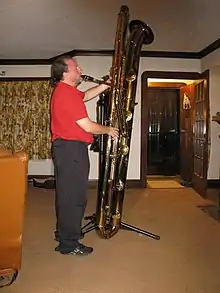Subcontrabass saxophone
The subcontrabass saxophone is the largest of the family of saxophones that Adolphe Sax patented in 1846 and planned to build, but never constructed. Sax called this imagined instrument the saxophone bourdon, named after the very low-pitched 32′ bourdon pedal stop on large pipe organs. It is a transposing instrument pitched in B♭ one octave below the bass saxophone, two octaves below the tenor, and three octaves and a major second below its written pitch.[1]
 | |
| Woodwind instrument | |
|---|---|
| Classification | Single-reed |
| Hornbostel–Sachs classification | 422.212-71 (Single-reed aerophone with keys) |
| Inventor(s) | Adolphe Sax |
| Developed | Conceived as part of Sax's 1846 patent; first playable instrument built by J’Élle Stainer in 2010 |
| Playing range | |
 | |
| Related instruments | |
|
Sizes:
Orchestral saxophones: Specialty saxophones: | |
| Musicians | |
| |
| Builders | |
| |
History
Although described in Adolphe Sax's patent in 1846, a practical, playable subcontrabass saxophone did not exist until the 21st century.[2] An oversized saxophone that might have qualified was built as a prop circa 1965; it could produce tones, but its non-functional keywork required assistants to manually open and close the pads, and it was reportedly incapable of playing a simple scale.[3]
The tubax was developed in two sizes in 1999 by German instrument manufacturer Benedikt Eppelsheim, the lower of which, pitched in B♭, he describes as a "subcontrabass saxophone".[4] This instrument provides the same pitch range as the saxophone bourdon would have, while the smaller tubax in E♭ covers the range of the contrabass saxophone. Whether or not the tubax is truly a saxophone is debated: it has the same fingering, but its bore, though conical, is narrower (relative to its length) than that of a regular saxophone.
The Brazilian instrument manufacturer J'Élle Stainer produced a working compact subcontrabass saxophone in 2010, which was shown that year at Expomusic.[1][5] In September 2012, Eppelsheim built the first full-size subcontrabass saxophone in B♭ (distinct from his B♭ tubax).[6] In July 2013, J'Élle Stainer completed a full-size subcontrabass saxophone.[7][8] It stands 2.74 metres (9 ft 0 in) high and weighs 28.6 kilograms (63 lb).[9]
See also
References
- Berni, Attilio (21 February 2013). "J'Elle Stainer Double Bb Sub-contrabass Saxophone". saxophone.org. Archived from the original on 22 November 2022. Retrieved 22 November 2022.
- Cottrell, Stephen (2012). The Saxophone. Yale Musical Instrument Series. New Haven: Yale University Press. p. 53. ISBN 978-0-300100-41-9. LCCN 2012028346. OCLC 844030644. OL 25377233M. Wikidata Q113952716.
- Green, Grant D. (2002). "Subcontrabass Saxophones (?)". Contrabass Compendium. Archived from the original on 27 September 2021. Retrieved 17 March 2007.
- "Tubax (B♭)". Munich, Germany: Benedikt Eppelsheim Wind Instruments. Archived from the original on 6 November 2022. Retrieved 6 November 2022.
- "Compact Subcontrabass". J'Élle Stainer Extreme Saxophones. Archived from the original on 21 November 2022. Retrieved 22 November 2022.
- "Custom made". Munich, Germany: Benedikt Eppelsheim Wind Instruments. Archived from the original on 29 November 2022. Retrieved 22 November 2022.
- "GWR Subcontrabass". J'Élle Stainer Extreme Saxophones. Archived from the original on 6 November 2022. Retrieved 6 November 2022.
- Berni, Attilio (saxophone); Romeo, Alfredo (drums); Antinozzi, Christian (bass); Crispolti, Alessandro (piano) (27 January 2021) [recorded 18 October 2020]. Sub contrabbasso J'Elle Stainer Eppelsheim soprillo (video). Maccarese, Italy: Museo del Saxofono. Retrieved 22 November 2022 – via YouTube.
- "Largest saxophone - playable by one person". Guinness World Records. 3 August 2013. Archived from the original on 21 November 2022. Retrieved 22 November 2022.
External links
- MP3 sound recording of the first movement of "Duet for Basses" by Walter Hartley, played as a B♭ Tubax duet (one instrument, overdubbed), performed by Jay C. Easton